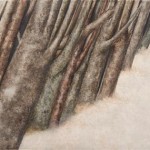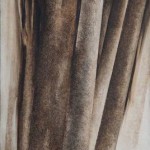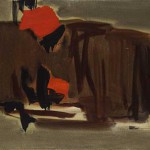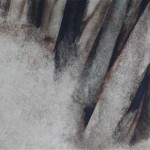In his paintings, Sohrab Sepehri strives for a poetic visualization of the ephemeral experience from a peripheral world. His travels to both the East and the West were critical in bringing about his unique style; just as his poetry was an all-telling document of his spirituality. His continuous struggle to benefit from the aesthetics of the West, along with his attention to the spiritual awareness of Eastern philosophy, as well the ‘Zen’ doctrines, combined to create a new imagery which has been said to be the crystallization of objective and subjective poetry.
At times the simplified illustration of nature in Sepehri’s work, as with the tree trunks in this piece, at times go as far as pure abstraction. These are representations of meditative moments in the world surrounding the artist that supposedly, with instantaneous improvisation, form a representation the moment of the unification of the artist and the spirit of being. The height of Sepehri’s attempt to grasp the combined meaning between painting and poetry was his creation of the “Tree Trunk” series during the 1970’s. This collection was almost exclusively done in oil on canvas in varying sizes with some being quite large. The unparalleled harmony between color and lines while attempting to create a semi-abstract atmosphere makes this one of the most recognizable of Sepehri’s paintings. From the spiritual significance of ‘tree’ in the ancient myths of Iran on the one hand, and the use of modern techniques resulting in concise and partially abstract illustration on the other, this combination increases the painting’s influence over the viewers and is a creation that resembles Sepehri’s poetry; simple and flowing yet meaningful.
This painting is an example of the most important series of Sepehri’s paintings that clearly represents his unique style. In this series, the selected natural subject matter, generally composed of a dense grove of trees, is a simplified and geometric representation of Sepehri’s personal expression. In this piece the colors, like in most of this artist’s paintings, are dark and mostly in hues of brown and ochre. He creates a strong and decisive composition with a limited amount of detail.
The depth of the image affects the viewer through Sepehri’s choice of colors as well as his comprehension of the essence of natural colors; the rising up of these real colors reflects the artist’s imagination and inner depth.
“His colors are ones that follow his composition and contemplative boundaries; a composition that answers his inner needs and feelings and concepts. It is for this reason he seeks the essence of earth, wind and plants […] Hence the remittance of the rules of light and shadow. The sun does not shine in some places, light is in the intestines of the work.”1 The texture of the paint in this work has given the bark of the trees a rough and porous feel that reminds us of Iran’s dark dense ancient forests. Yet they alternately gain form from the two-dimensional canvas and once again change form through the rhythm of the colors. The artist’s clear representation of the tree’s bark is so close to an abstract image that one from even a close distance has difficulty in recognizing them. The unity one feels through the density of these grandiose trees is an association to his poem ‘The Size of Green’ which he wrote during this time. In some ways, his abstention from portraying the minor details such as leaves and branches makes this painting much more than an illustration of a few tree trunks. He creates a ‘familiar’ painting that consistently becomes ‘unfamiliar’ and in this ‘unfamiliarity,’ the trees become ‘examples’ that seem to be of another world; the world of images, imagination and the mindset of painting which are the result of the depth of nature.
Sepehri’s paintings in fact are translations of his poetry and exhibit a simplistic imagery. They are a simplification of his humanistic search for existence. In the same way that he is an innovator in his poetic imagery, he is a complete modernist in his subject matter and definition of illustrative painting. Even in their subject matter his paintings have a world view; the subject of nature, trees, rocks and life echoes in each of them. If we seek something Iranian in his work, we must search through his naturalism with respect to Iranian mysticism or to what has been written about ancient culture and moods in the history books. Yet, as soon as we ponder what is Iranian in his work, we should never expect an implicit reference to the tradition of Iranian illustration; neither in its infrastructure nor even in its integral parts such as color, form or composition. We see no temptation or tendency towards calque from the traditional Iranian decorative handicrafts, like what would be found in miniatures, carpets or architecture in his work. Sepehri never had any appreciation for tradition and his world of images can never be found to be traditional in the least bit. He was a true modernist with a perspective that came out of an understanding for nature and the surrounding world and these are not things that have their roots in traditional Iranian art.
The result of all of Sepehri’s meditation and contemplation was attaining a pure visual identity that allowed his paintings to reach where they are today, having a place as a part of the most recognizable and valuable works of modern Iranian art. His works constantly breaking records in national and international auctions is the proof of this claim. A painting of his selling for $665,000 at Christie’s Dubai auction in 2011 is a testament to his unique and valuable artwork that Sepehri was able to leave behind as his legacy after a lifetime of painting. Yet another of his paintings broke this international record in Tehran in 2014, selling for $1,800,000 and setting a new record for his work.






